Today’s dish Baked Salmon in Foil with Ponzu Dressing is quite easy to make but flavoursome. It is a great way to enjoy the natural flavours of each ingredient in a foil bag. You can of course change your choice of fish and vegetables – combinations are limitless.
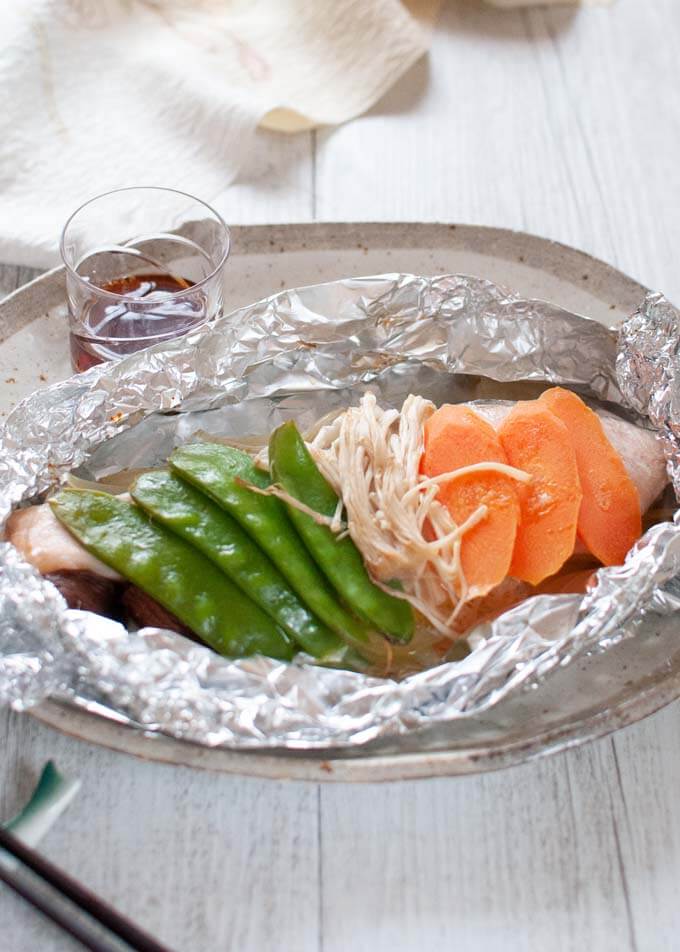
This is no doubt a Western-style dish but what’s inside the foil is quite simple with only a few flavours added to it for a good reason – they are to be eaten in the Japanese way with Ponzu dressing.
Unlike most Salmon in Foil dishes, my dish uses minimum oil so that the dish becomes super light with oil-free ponzu dressing. I must say today’s dish is one of those Western dishes which were Japanised (is there a such word?) to be simpler and lighter so you can enjoy the natural flavours of the ingredients.
What’s Inside the foil?
I use thinly sliced onions as an underlay for the salmon fillet to sit on. The sliced onions prevent the salmon from sticking to the foil as well as infusing good flavours into the fish.
On top of the salmon are carrot slices, enoki mushrooms, snow peas and shiitake mushrooms. Place a little knob of butter in the middle on top of the vegetables, then seal the foil and cook.
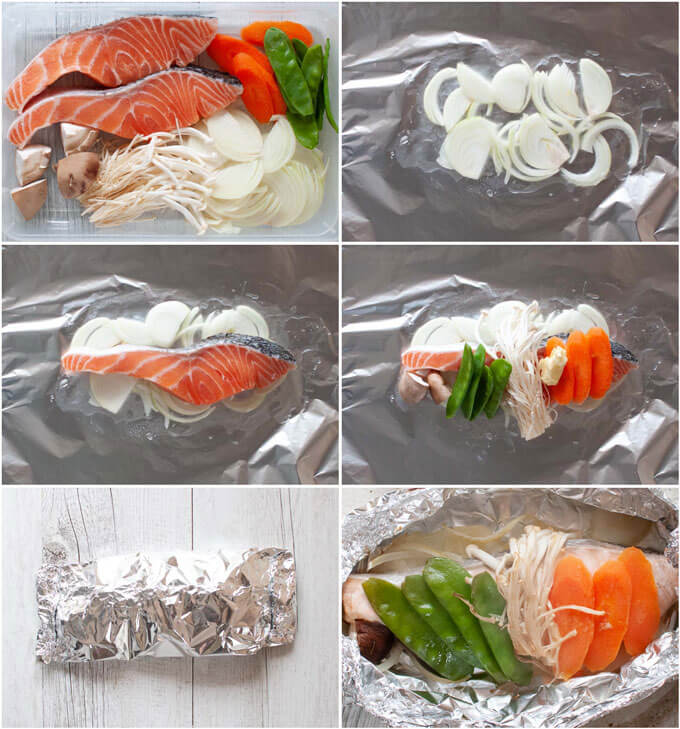
You can use a different fish fillet. But avoid fishy red meat fillets, such as mackerel. Any white meat fish is great.
The vegetables can be any that can be steamed within 15 minutes, e.g. broccoli, green beans, sliced potatoes, shimeji mushrooms and zucchini. Make sure that the vegetables are cut to different sizes so that they cook through at the same time.
Cooking Methods
In Australia, almost every household has an oven so I use an oven to bake the fish and vegetables in foil. It only takes about 15 minutes to cook.
But when I was in Japan I did not have an oven. So, I used a frying pan with a lid to heat up the foil bag to cook – pan baked method. Surprisingly, it takes slightly less time than cooking it in the the oven.
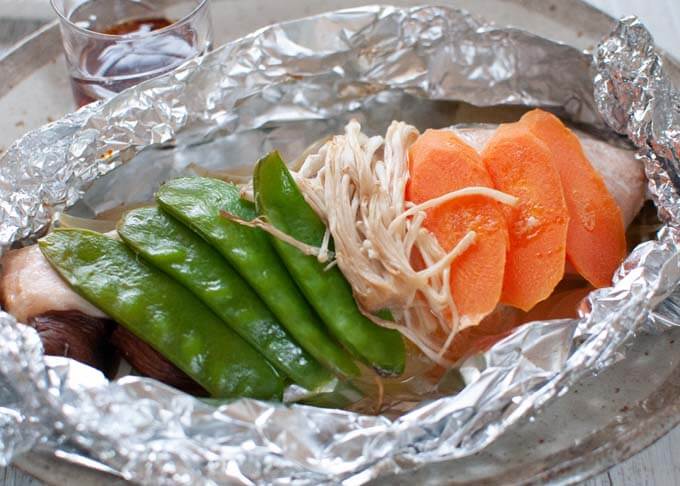
The only downside of cooking it in a frying pan is that the bottom of the foil tends to heat up too much and you might end up with charred onions that were hit by the direct heat.
It is quite unfortunate if this happens as the onions are very tasty as they suck up the salmon juices while being cooked. So, make sure that the heat is brought down to low heat per the recipe instructions.
Ponzu Dressing for Baked Salmon in Foil
I tried Salmon in Foil with lemon juice and/or garlic, or olive oil and herbs added to it. The ingredients are seasoned sufficiently before wrapped in foil.
But for me, simply cooking the ingredients with almost no seasoning and eating them with Ponzu Dressing is the best way. I can even adjust the amount of Ponzu and enjoy the original flavour of each ingredient.
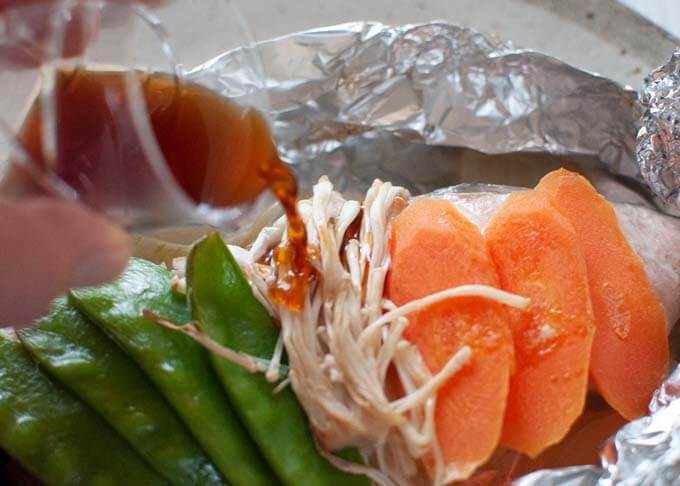
Ponzu Dressing is a citrus-based sauce that is made of soy sauce, bonito flakes, knob (dried kelp) and citrus juice. It is tart and salty with all of umami. The details of how to make Ponzu is in my post Japanese Dressings.
As you will see in the recipe ingredients, there is hardly any flavouring added to the fish and vegetables inside the foil bag – just a little knob of butter to be exact.
It is a much plainer and lighter dish than other recipes which, I think, makes it a typical traditional Japanese flavouring.

Today’s dish is something you can get your kids to help with during the preparation. My children probably don’t remember but I made them help place vegetables on top of the fish when I was making this dish for the family.
Teaching them how to neatly wrap the food in foil was a bit of a challenge but I can tell you that it’s much easier than origami folding!
Yumiko![]()
P.S. Don’t forget to see the section ‘MEAL IDEAS’ below the recipe card! It gives you a list of dishes that I have already posted and the new recipe in this post that can make up a complete meal. I hope it is of help to you.
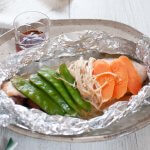
Today’s dish Baked Salmon in Foil with Ponzu Dressing is quite easy to make and flavoursome. It is a great way to enjoy the natural flavours of each ingredient in a foil bag. The choice of fish and vegetables are flexible.
Prep time does not include time required to make Ponzu.
- 2 x 150g/5.3oz salmon fillets (note 1)
- 100g/3.5oz onion , thinly sliced
- 30g/1.1oz carrot , sliced diagonally to 5mm thick (note 2)
- 30g/1.1oz enoki mushrooms , roots removed (note 2)
- 1-2 shiitake mushrooms , remove the stem and cut to quarter or half (note 2)
- 30g/1.1oz snow peas ends removed (note 2)
- 6g/0.2oz butter
- oil
- 2 x 40cm/1.3ft long sheet of foil
- Ponzu (note 3)
-
If using oven, pre-heat the oven to 200C/392F.
-
Lightly oil the centre of each piece of foil, drawing an elongated oval so that the salmon fillet can fit in the oiled area.
-
Spread the sliced onions on the oiled area of each piece of foil so that the salmon can nicely sit on them.
-
Place the salmon on the scattered onion, top with sliced carrots, enoki mushrooms, snow peas and shiitake mushrooms. Try to spread vegetables on the salmon fillets in clusters but to cover the salmon (see the photos).
-
Place 3g butter on top of the vegetables in the centre of each fillet.
-
Pick up the end of the foil on your side and the opposite side and fold the both sides together a few times to seal. Then fold left and right sides a few times individually to seal the bag.
-
If cooking in the oven, place the foil bags on a tray and cook for 13-15 minutes.
-
If cooking on a stove top, place the bags in a frying pan, without overlapping, with a lid on. Cook over medium heat for 4 minutes, then turn down the heat to low and cook further 7-8 minutes.
-
Place each bag on a plate and serve with ponzu dressing. To eat, open the bag and pour ponzu dressing over the fish and vegetables.
1. I made two fillets from a salmon cutlet by removing the bone in the middle. Please see my post Japanese Salmon Mirin-zuke (Mirin Marinade) to see how I make two fillets from one cutlet. You will need a large cutlet of about 320g/0.7lb.
You can use salmon fillets but then, you may want to remove the skin before cooking.
Instead of salmon, you can use other fish fillets but avoid fishy red meat fillets such as mackerel.
2. The vegetables used on the salmon fillets can be substituted with other vegetables such as broccoli, green beans, other mushrooms, and sliced potatoes. Make sure that the vegetables are cut to appropriate sizes so that they will be cooked just right. For example, do not slice potatoes too thin or too thick (about 1cm thick might be just right).
3. Ponzu is a soy based citrus flavoured dressing. Please see my recipe, Japanese Dressings, which includes how to make Ponzu. I recommend you make Ponzu ahead of time as the longer you keep it in the fridge, the better the flavour.
Alternatively, you can use store-bought Ponzu Dressing, which is available at Japanese/Asian grocery stores.
Another alternative is to pour some lemon juice and soy sauce.
4. Nutrition per serving, assuming 1 tablespoon Ponzu Dressing is used.
serving: 286g calories: 430kcal fat: 28g (43%) saturated fat: 6.5g (33%) trans fat: 0.1g polyunsaturated fat: 6.8g monounsaturated fat: 9.7g cholesterol: 89mg (30%) sodium: 352mg (15%) potassium: 834mg (24%) carbohydrates: 12g (4%) dietary fibre: 2.6g (10%) sugar: 5.5g protein: 33g vitamin a: 61% vitamin c: 36% calcium: 3.1% iron: 7.2%
Meal Ideas
A typical Japanese meal consists of a main dish, a couple of side dishes, a soup and rice. I try to come up with a combination of dishes with a variety of flavours, colours, textures and make-ahead dishes.
The main dish is eaten with ponzu dressing so I picked side dishes with non-acidic flavours. Since Side dish 2 is miso flavoured, I thought clear soup would be more appropriate. But if you like miso soup better, you can of course serve any kind of miso soup.
- Main: Baked Salmon in Foil with Ponzu Dressing – today’s recipe
- Side dish 1: Green Beans with Tofu Dressing (Shira-ae)
- Side dish 2: Miso Glazed Eggplant (Nasu Dengaku) – make ahead miso glaze
- Soup: Japanese Style Egg Drop Soup (Kakitama-jiru) – or other clear soup
- Rice: Cooked Rice
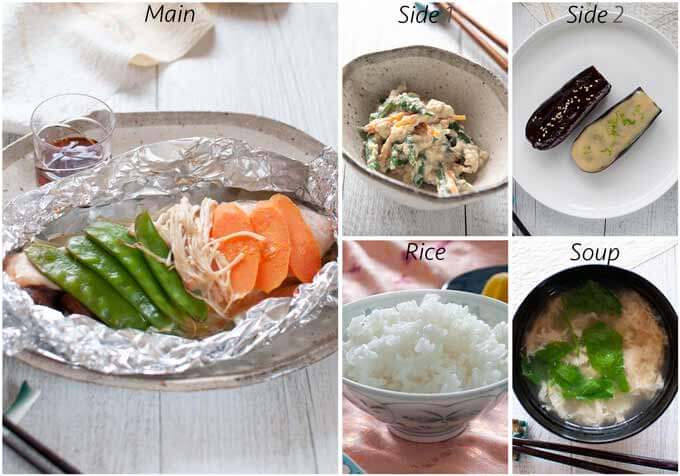
Dear Yumiko
This was so delicious! My family love the flavours from the ponzu with the onions and veges. So well balanced and agreeable. I love that it was so natural and satisfying at the same time. Thank you! My daughter said she felt like we were dining in a Japanese restaurant!
Hi SH, you got a great compliment from your daughter! I am glad everyone enjoyed it.
Hello,
Are there sauces to recommend besides ponzu sauce for this dish? Thank you
Hi Jane, lemon + soy sauce would be the best. Thanks for asking. I added this to the recipe note.
You could melt a small amount of butter and pour over it with some lemon juice but the flavour becomes a bit more Westernised.
You are using a Salmon Steak, Any fish portioned across the and perpendicular tot he backbone is a steak. A filler isthe side of the fish, taken usually each side of the backbone with or without the pin bones. No matter how you portion the steak it is still a steal and not a fillet.
Hi Wayne, thanks for pointing it out. I know that and perhaps I could have called it half steak or something. The way I made two salmon pieces from a steak (cutlet in Australia) results in salmon fillets that were thinly sliced perpendicular to the backbone. So, it could be a sliced fillet too. Perhaps, I could mention that wide salmon fillet can be sliced into few narrow fillets to make it the same.
This will be a good recipe to try! Thanks. Tell me more about those carrots. They look huge + you have sliced them in an interesting way.
Hi Janet, do they look big? I used a normal carrot which was probably about 3-4cm in diameter. After peeling, I sliced diagonally. The sharper diagonal angle you slice, the longer the oval shape of the sliced carrots gets. It’s a pretty easy recipe so, please try it.